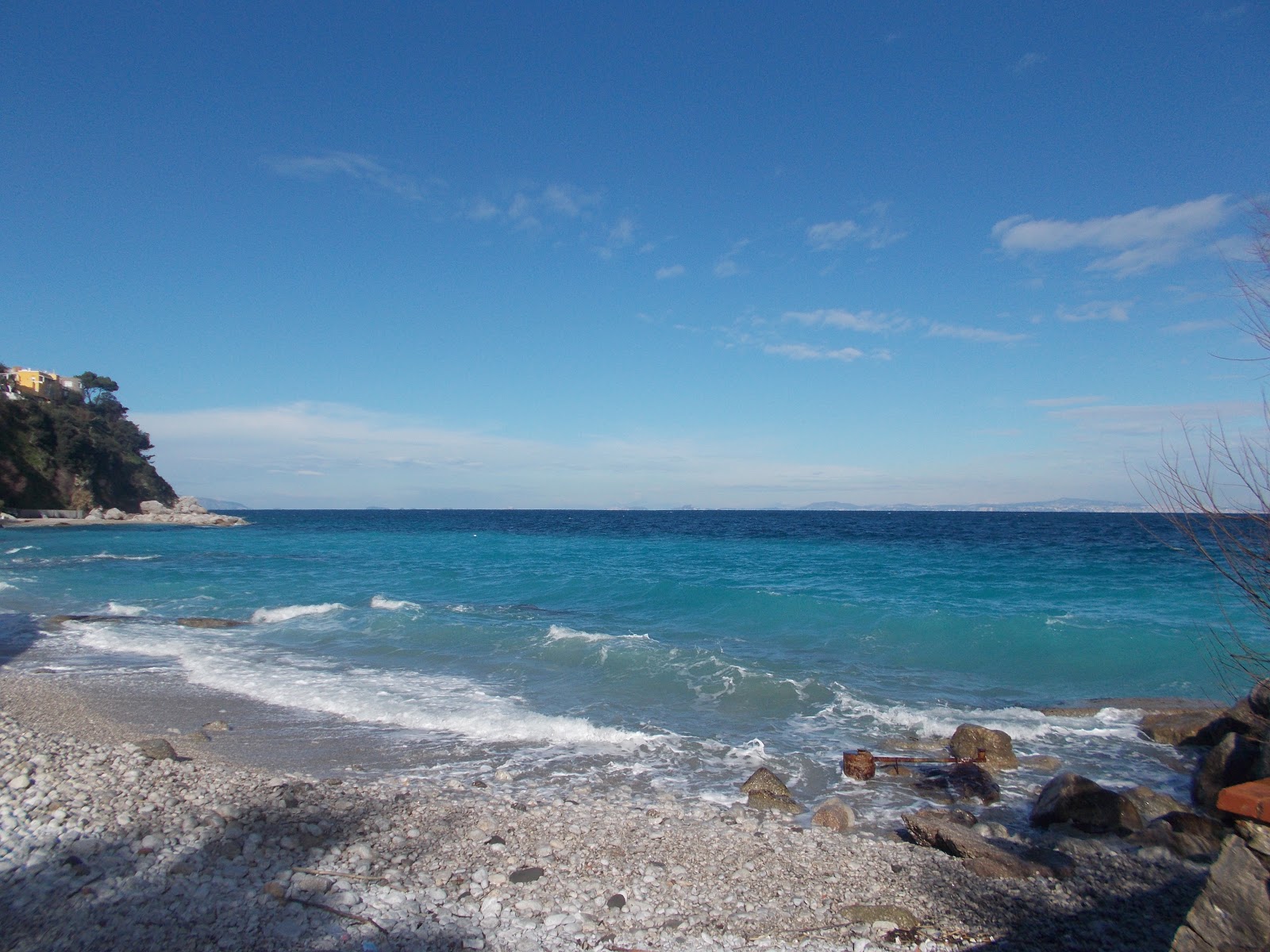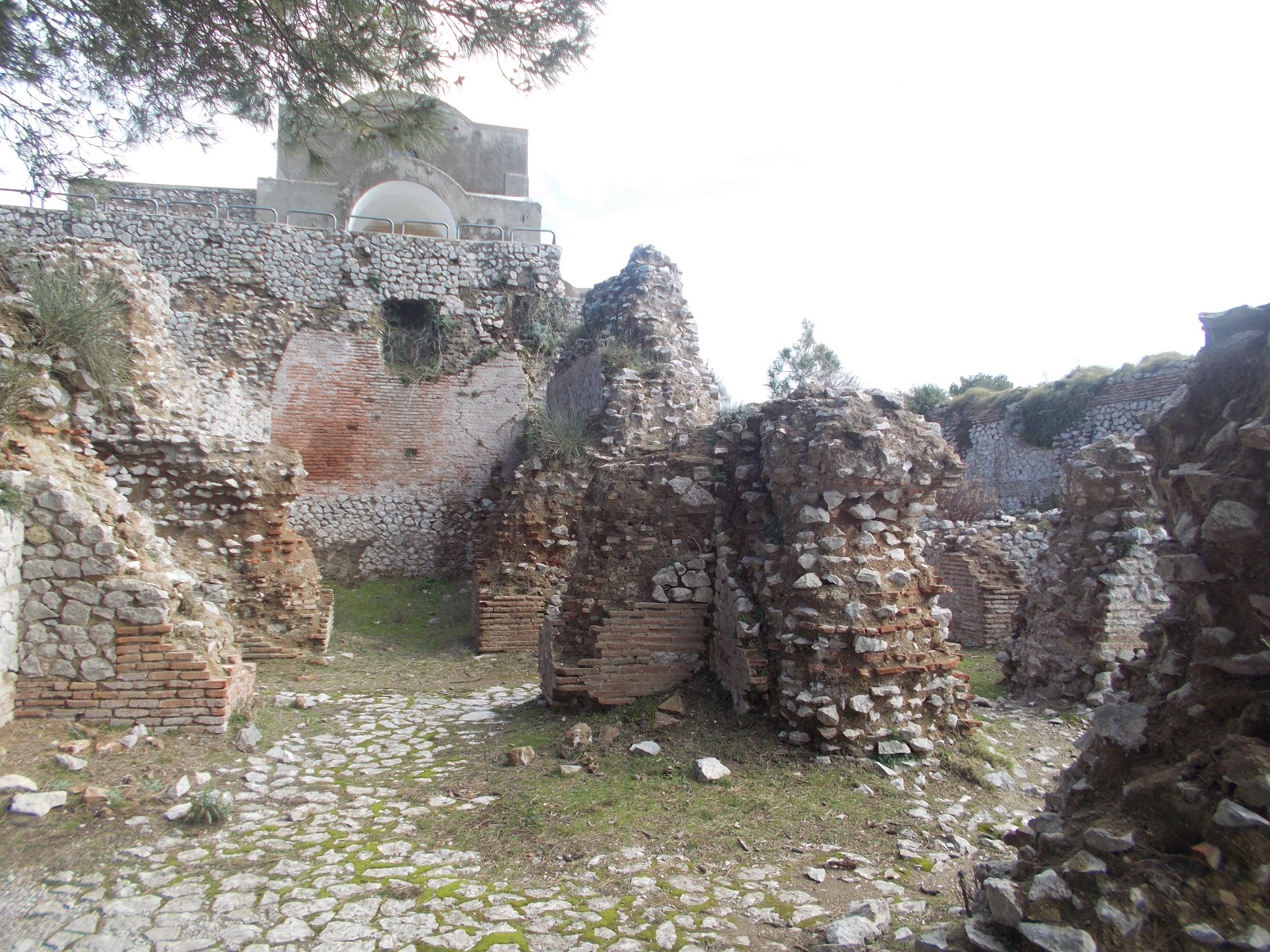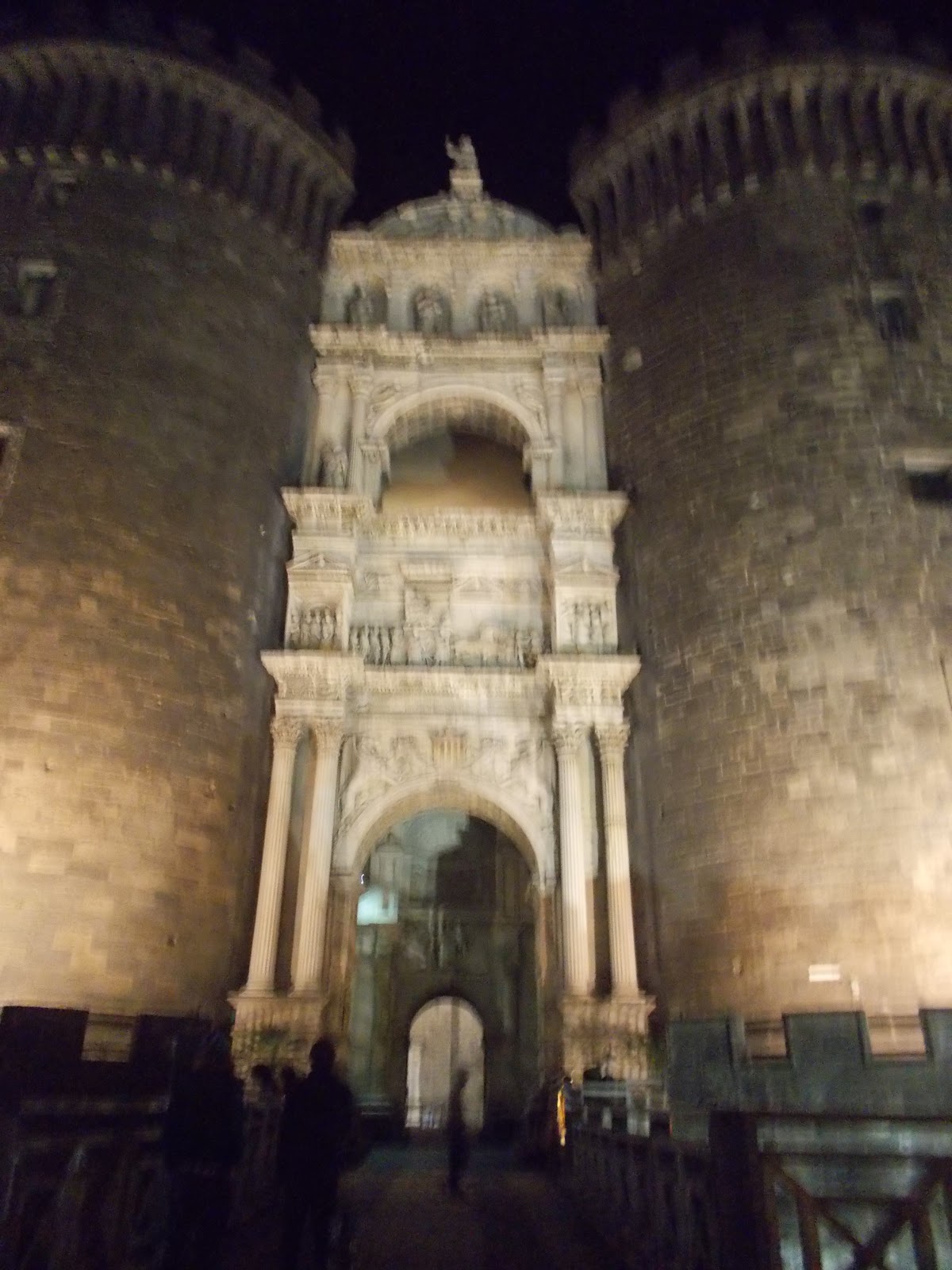For my first long weekend away from Rome, some friends and I went to Naples to visit it and the surrounding area. After class we rushed to the bus stop and made our way to the train station. The train ride took the better part of the afternoon and we arrived in Naples in time for a late dinner. After spending the night in Naples we arose early and we took the ferry to the Island of Capri.
(Coast of Capri)
The Island of Carpi is perhaps one of the most beautiful
places in the world. It has mountains, the sea, and a pleasant little town all
wrapped together in a neat little island. The town is nice and relatively clean,
not as though it has been scrubbed to the point of sterility, but as though the
townspeople liked to keep it tidy. Capri did not have much, but what it had was
kept bright and smiling by all the bright and smiling people. Even the stray
dogs wandering through the streets seemed friendly.
(Lively Little Town of Capri)
One dog was
particularly welcoming. He was small with brown and black coloring and had a
little bandana tied around his neck. Whether he had a family which allowed him
to wander the streets, or whether he was simply a town favorite who everyone
loved and cared for I cannot say with any certainty. This second option might
sound somewhat unrealistic, but if you had seen him, you would understand that
this doesn’t feel implausible at all. He seemed just as much a part of the town
and scenery as the houses and trees. He strolled around sniffing every table
and wagging his tail at the sight of every passerby. He didn’t prance around as
though he owned Capri, he was just a little piece of it.
After saying hello to the dog, and petting him and making
much of him, we went on to explore the island. There were happy little
alleyways with cute shops nestled into them, and short buildings and broad
plazas. Occasionally we would see the little dog walking about and doing
whatever dogs do when they are just being dogs.
We decided to enter a small church and the little dog came
in after us. This was a bit of a surprise to us. We were about to put him back
outside when a friendly old man approached us.
“No, no, it’s OK,” He said, “Here we say, ‘the dog, he does
no harm.’ He is welcome anywhere he goes. God’s house is open to all. The dogs
they can go anywhere. ”
With his assurance we left the dog to wander the aisles and
sit in the chapels while we explored the church. It was a pleasant church with
white walls and lovely decorations. My favorite part was a little chapel dedicated
to St. Monica, the Mother of St. Augustine. I think they might have had a relic
buried there.
Afterward we hiked up to the top of the hill on Capri to
visit the remains of Tiberius’s villa. We arrived at the top of the hill only
to find the fence gate was closed. We began to discuss what we should do next. Soon
a man came and explained to us that the villa was closed that day. Seeing our
disappointment the man opened the gate for us anyway and let us in.
(Tiberius's Villa)
Tiberius’s villa was actually smaller than I expected. For the last few years of his reign Tiberius
grew tired of running the Roman Empire. He closed all his offices in Rome and spent
the rest of his life relaxing at Capri. Thus Rome was without good government
for a time, and great harm was done. Meanwhile Tiberius no doubt enjoyed
himself on this lovey island.
At the highest point of the villa I was surprised to find a
statue of Mary with a crown, and Christ the King in her arms. Apparently a
church was constructed long after the villa had fallen into disrepair. Unfortunately,
the Church was not open that day so we could not go in.
(Satue of Crowned Madonna)
At last we returned down the hill to the coast. As we waited
in a restaurant for the ferry to show up, the dog we had met earlier came
wandering in. We decided to start calling it The Ghost Dog, because it
mysteriously appeared wherever we went. At last the ferry arrived and we
departed from the island.
(View of Sunset from Ferry)
We spent the next day in Naples. The word Naples comes from the Greek for ‘New City.’ This area was the first place the Greeks came to when they sent colonies to Italy. Today, the City of Naples is perhaps one of the most dreary places I have seen. It has bad government, lack of respect for law, and a strong mafia presence all rolled up into one dying city. Naples is a large, dirty city, as though no one had bothered to sweep the streets or wipe the walls of the buildings in the past six months. It had lots of wonderful things, churches, plazas and museums. The city might have been very nice if the people had taken the time to nurse it back to health. There were dogs here as well darting around the edges like shadows or disappearing into the crowds.
The
metro was rather confusing, not because there were too many lines or too few
maps but because there was no way of knowing how to enter. We could find no place to purchase tickets,
and most of the Italians were simply walking through without scanning anything.
At last we decided that if there wasn’t anywhere to buy tickets, and if the
Italians didn’t seem to use them either, then it must be alright for us to just
use the metro. Thus we walked through the open gates with no one to prevent us.
But whether the Metro was a service offered to the public free of charge, or
whether the Rule of Law had so broken down in Naples that even the citizens
ceased to care for it, I cannot say.
The city had several crowded plazas
and many narrow streets and alleys. As we passed through we saw garbage heaped
up on the side of some roads, and graffiti scrawled upon every surface in reach.
It was so dense that there seemed to be no room for any more. Most of the
street art was scribbled pictures, scrawled profanities and pornography. Some, however awful they were, looked as
though they required more skill. One picture was of a small helpless deer,
similar in appearance to Bambi. The fawn was lying upside-down with bright red
drops running down the wall from its bleeding carcass. I may be misremembering,
but I think red tears were dripping from her frightened eyes. The sight of such
a noble and gentle creature held in such contempt as to be shown in such a way
struck me as one of the most horrifying images I had ever seen. It was as
though the maker of the drawing was unable to comprehend the beauty of purity
and innocence.
After visiting various churches we went
to a museum which had once been a chapel. After crossing the street to purchase
tickets we returned and entered into the building. It was not a large building,
but it had several fascinating sculptures. In the center was a representation
of Christ after his death. It showed him wrapped in a shroud. The artist was
able to convey the sense of several different kinds of cloth with the stone he
was working with. The wrinkled shroud which barely seemed to hide the figure
beneath did not provide a sense of peace or calm, but only served to heighten
the memory of the intense suffering which had begun with His tears in the
garden.
(I got this picture online)
In the evening after the sun had set we spent some time
exploring the nearby area. We stopped to get some gelato from a shop in an open
mall. The mall was like an enormous hallway intersecting another enormous
hallway lined with stores and shops. There were no doors to bar entry, only a
high ceiling and bright welcoming lights. There were statues and figures carved
into the building itself, while real people walked about the marble floor doing
whatever personal business people have to do when they are out and about.
That night we also saw a castle in the middle of the city. Unfortunately
it was closed for the evening, but as my literature professor has said, castles
look more impressive from the outside. So
it is just as well.
The last thing we saw was a
magnificent church. From the outside it looked like it was modeled off of the
Pantheon in Rome. We peered into the door way. Inside it was brightly lit with
statues of saints around the curved walls. Red velvet drapery hung accented by
golden lining. I was looking forward to entering in but Mass was just ending
and some in our group were still finishing their gelato. So we waited for a
bit. Right when we were ready to enter, the doors were closed and the church
shut up for the night.
The following day we set out for Pompeii. We took a train and eventually arrived at the gates of the ancient city. Pompeii was once a busy Roman city on the Bay of Naples near Mt. Vesuvius. Unfortunately, this mountain turned out to be a volcano. It erupted and buried the city under a pile of ash. This killed everyone in the city, but preserved the buildings until they could be uncovered. The vast extent of row upon row of ancient houses spread out before us. We wandered through the barren streets, now full of tourists. We were totally surrounded and immersed in the dusty surroundings of the dead city.
(Street in Pompeii with Mt. Vesuvius)
Many of the houses were closed off, preventing us from going inside. We could only stand in the door-less openings and peer into the buildings. There we saw mosaics, frescos, and other scattered bits of ruins in the empty rooms. We walked down the street with these abandoned buildings on either side until we came, at last, to the Amphitheater. Most of the entrances were sealed, but we eventually found one which allowed us inside. Here games were held and public spectacles were shown for the entertainment of the entire city. Now the inside is nothing but a patch of mud and grass surrounded by empty seats.
(Inside)
(Outside)
The same was true of all the other buildings we passed. The houses were vacant, the theater remained motionless, the temples sat barren, and the altars stood unused. All were lifeless and empty, completely closed for business. Only the tourists wandered around the dusty streets taking tours, listening to audio guides, snapping photos, and engaging in all manner of touristy activities.
We saw one place which I like to think of as an ancient Roman fast food restaurant. Romans would stop by to grab some food to go, or send a slave to pick up a quick snack for them while they relaxed at the bath. The counter had several empty holes for pots which would hold nuts or olives or some other snack food. The customer would scoop what they wanted in a bag and pay at the counter. This was possibly the first trail mix.
Outside the open gates of the city were several tombs. There
were larger tombs and smaller tombs and all sorts of tombs to show the grandeur
and status of those who were buried there.
These may be the only houses to retain their original occupants.





















You set up a compelling contrast between Capri and Naples. And I liked reading about the ghost dog and your notion of "McMarcus Trail Mix". :)
ReplyDelete